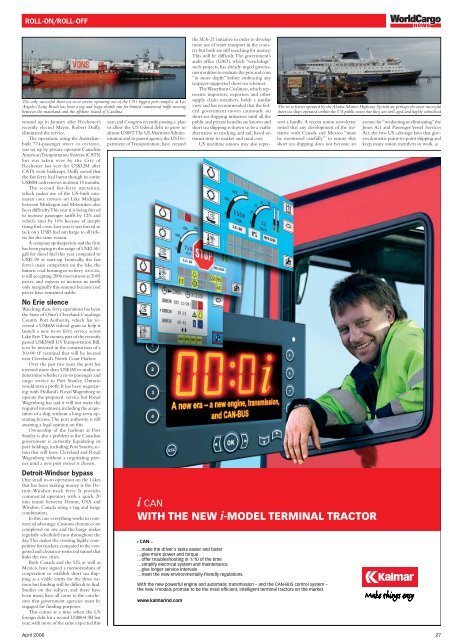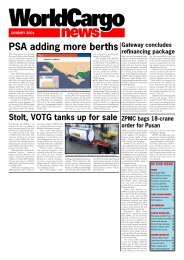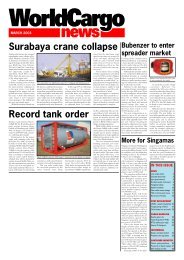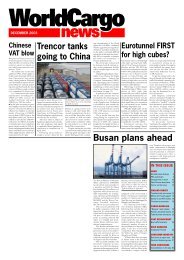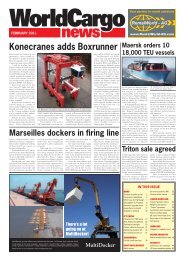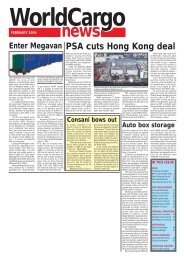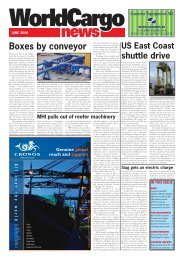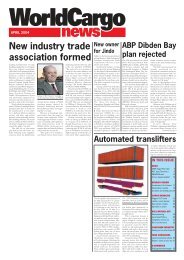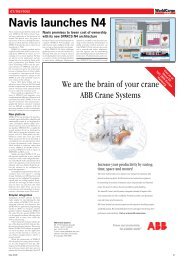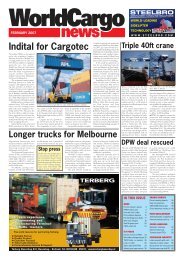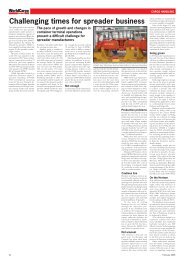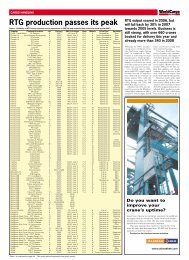WorldCargo News Online
WorldCargo News Online
WorldCargo News Online
Create successful ePaper yourself
Turn your PDF publications into a flip-book with our unique Google optimized e-Paper software.
ROLL-ON/ROLL-OFF<br />
<strong>WorldCargo</strong><br />
news<br />
The only successful short sea ro-ro service operating out of the US’s biggest port complex at Los<br />
Angeles/Long Beach has been a tug and barge shuttle run for limited commercial traffic moving<br />
between the mainland and the offshore island of Catalina<br />
wound up in January after Rochester’s<br />
recently elected Mayor, Robert Duffy,<br />
eliminated the service.<br />
The operation, using the Australianbuilt<br />
774-passenger SPIRIT OF ONTARIO,<br />
was set up by private operator Canadian<br />
American Transportation Systems (CATS)<br />
but was taken over by the City of<br />
Rochester last year for US$32M after<br />
CATS went bankrupt. Duffy noted that<br />
the fast ferry had burnt though its entire<br />
US$8M cash reserves in about 10 months.<br />
The second fast-ferry operation,<br />
which makes use of the US-built catamaran<br />
LAKE EXPRESS on Lake Michigan<br />
between Muskegon and Milwaukee, also<br />
faces difficulty.This year it is being forced<br />
to increase passenger tariffs by 12% and<br />
vehicle rates by 10% because of steeply<br />
rising fuel costs. Last year it was forced to<br />
tack on a US$5 fuel surcharge to all tickets<br />
for the same reason.<br />
A company spokesperson said the firm<br />
has been paying in the range of US$2.50/<br />
gall for diesel fuel this year compared to<br />
US$1.90 at start-up. Ironically, the fast<br />
ferry’s main competitor on the lake, the<br />
historic coal-burning ro-ro ferry BADGER,<br />
is still accepting 2006 reservations at 2005<br />
prices, and expects to increase its tariffs<br />
only marginally this summer because coal<br />
prices have remained stable.<br />
No Erie silence<br />
Watching these ferry operations has been<br />
the State of Ohio’s Cleveland-Cuyahoga<br />
County Port Authority, which has received<br />
a US$6M federal grant to help it<br />
launch a new ro-ro ferry service across<br />
Lake Erie.The money, part of the recently<br />
passed US$286B US Transportation Bill,<br />
is to be invested in the construction of a<br />
30,000 ft 2 terminal that will be located<br />
near Cleveland’s North Coast Harbor.<br />
Over the past two years the port has<br />
invested more than US$1M in studies to<br />
determine whether a ro-ro passenger and<br />
cargo service to Port Stanley, Ontario<br />
would turn a profit. It has been negotiating<br />
with Holland’s Royal Wagenborg to<br />
operate the proposed service but Royal<br />
Wagenborg has said it will not make the<br />
required investment, including the acquisition<br />
of a ship, without a long-term operating<br />
license.The port authority is still<br />
awaiting a legal opinion on this.<br />
Ownership of the harbour at Port<br />
Stanley is also a problem as the Canadian<br />
government is currently liquidating its<br />
port holdings, including Port Stanley, action<br />
that will leave Cleveland and Royal<br />
Wagenborg without a negotiating partner<br />
until a new port owner is chosen.<br />
Detroit-Windsor bypass<br />
One small ro-ro operation on the Lakes<br />
that has been making money is the Detroit-Windsor<br />
truck ferry. It provides<br />
commercial operators with a quick 20<br />
min transit between Detroit, USA and<br />
Windsor, Canada using a tug and barge<br />
combination.<br />
In this case everything works to commercial<br />
advantage. Customs clearances are<br />
completed on site and the barge makes<br />
regularly scheduled runs throughout the<br />
day.This makes the crossing highly competitive<br />
for truckers, compared to the congested<br />
and clearance-restricted tunnel that<br />
links the two cities.<br />
Both Canada and the US, as well as<br />
Mexico, have signed a memorandum of<br />
cooperation to establish short sea shipping<br />
as a viable entity for the three nations<br />
but funding will be difficult to find.<br />
Studies on the subject, and there have<br />
been many, have all come to the conclusion<br />
that government agencies must be<br />
engaged for funding purposes.<br />
This comes at a time when the US<br />
foreign debt hit a record US$804.9B last<br />
year, with more of the same expected this<br />
year, and Congress recently passing a plan<br />
to allow the US federal debt to grow to<br />
almost US$9T.The US Maritime Administration<br />
and its parent agency, the US Department<br />
of Transportation, have created<br />
the SEA-21 initiative in order to develop<br />
more use of water transport in the country<br />
but both are still searching for money.<br />
This will be difficult.The government’s<br />
audit office (GAO), which “watchdogs”<br />
such projects, has already urged government<br />
entities to evaluate the pros and cons<br />
“in more depth” before embracing any<br />
taxpayer-supported short sea schemes.<br />
The Waterfront Coalition, which represents<br />
importers, exporters and other<br />
supply chain members, holds a similar<br />
view and has recommended that the federal<br />
government moves cautiously on<br />
short sea shipping initiatives until all the<br />
public and private benefits are known and<br />
short sea shipping is shown to be a viable<br />
alternative to trucking and rail, based on<br />
transit time to market and total cost.<br />
US maritime unions may also repre-<br />
The ro-ro ferries operated by the Alaska Marine Highway System are perhaps the most successful<br />
short sea ships operated within the US public sector, but they are well aged and highly subsidised<br />
sent a hurdle. A recent union newsletter<br />
noted that any development of the initiative<br />
with Canada and Mexico “must<br />
be monitored carefully’” to ensure that<br />
short sea shipping does not become an<br />
i CAN<br />
WITH THE NEW i-MODEL TERMINAL TRACTOR<br />
i CAN…<br />
…make the driver’s tasks easier and faster<br />
…give more power and torque<br />
…offer troubleshooting in 1/10 of the time<br />
…simplify electrical system and maintenance<br />
…give longer service intervals<br />
…meet the new environmentally-friendly regulations.<br />
With the new powerful engine and automatic transmission – and the CAN-BUS control system –<br />
the new i-models promise to be the most efficient, intelligent terminal tractors on the market.<br />
www.kalmarind.com<br />
avenue for “weakening or eliminating” the<br />
Jones Act and Passenger Vessel Services<br />
Act, the two US cabotage laws that govern<br />
domestic point-to-point shipping and<br />
keep many union members in work. ❏<br />
April 2006 27


